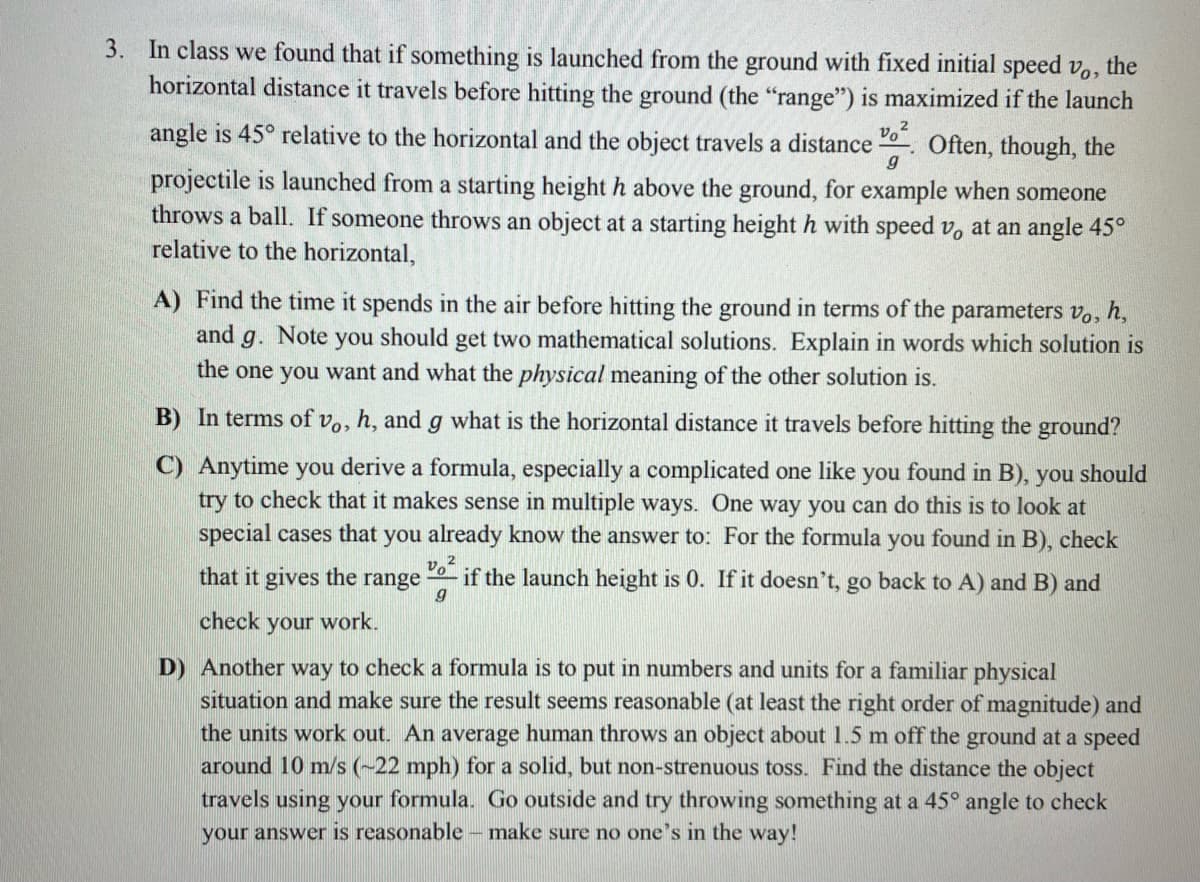3. In class we found that if something is launched from the ground with fixed initial speed v,, the horizontal distance it travels before hitting the ground (the "range") is maximized if the launch angle is 45° relative to the horizontal and the object travels a distance Often, though, the projectile is launched from a starting height h above the ground, for example when someone throws a ball. If someone throws an object at a starting height h with speed vo at an angle 45° relative to the horizontal, A) Find the time it spends in the air before hitting the ground in terms of the and g. Note you should get two mathematical solutions. Explain in words which solution is the one you want and what the physical meaning of the other solution is. parameters vo, B) In terms of vo, h, and g what is the horizontal distance it travels before hitting the ground? C) Anytime you derive a formula, especially a complicated one like you found in B), you should try to check that it makes sense in multiple ways. One way you can do this is to look at special cases that you already know the answer to: For the formula you found in B), check that it gives the range if the launch height is 0. If it doesn't, go back to A) and B) and check your work.
3. In class we found that if something is launched from the ground with fixed initial speed v,, the horizontal distance it travels before hitting the ground (the "range") is maximized if the launch angle is 45° relative to the horizontal and the object travels a distance Often, though, the projectile is launched from a starting height h above the ground, for example when someone throws a ball. If someone throws an object at a starting height h with speed vo at an angle 45° relative to the horizontal, A) Find the time it spends in the air before hitting the ground in terms of the and g. Note you should get two mathematical solutions. Explain in words which solution is the one you want and what the physical meaning of the other solution is. parameters vo, B) In terms of vo, h, and g what is the horizontal distance it travels before hitting the ground? C) Anytime you derive a formula, especially a complicated one like you found in B), you should try to check that it makes sense in multiple ways. One way you can do this is to look at special cases that you already know the answer to: For the formula you found in B), check that it gives the range if the launch height is 0. If it doesn't, go back to A) and B) and check your work.
Related questions
Question

Transcribed Image Text:3. In class we found that if something is launched from the ground with fixed initial speed vo, the
horizontal distance it travels before hitting the ground (the "range") is maximized if the launch
angle is 45° relative to the horizontal and the object travels a distance
vo
Often, though, the
projectile is launched from a starting height h above the ground, for example when someone
throws a ball. If someone throws an object at a starting height h with speed v, at an angle 45°
relative to the horizontal,
A) Find the time it spends in the air before hitting the ground in terms of the parameters vo, h,
and g. Note you should get two mathematical solutions. Explain in words which solution is
the one you want and what the physical meaning of the other solution is.
B) In terms of vo, h, and g what is the horizontal distance it travels before hitting the ground?
C) Anytime you derive a formula, especially a complicated one like you found in B), you should
try to check that it makes sense in multiple ways. One way you can do this is to look at
special cases that you already know the answer to: For the formula you found in B), check
that it gives the range
if the launch height is 0. If it doesn't, go back to A) and B) and
g
check your work.
D) Another way to check a formula is to put in numbers and units for a familiar physical
situation and make sure the result seems reasonable (at least the right order of magnitude) and
the units work out. An average human throws an object about 1.5 m off the ground at a speed
around 10 m/s (~22 mph) for a solid, but non-strenuous toss. Find the distance the object
travels using your formula. Go outside and try throwing something at a 45° angle to check
your answer is reasonable - make sure no one's in the way!
Expert Solution
Step 1
Solution:
a). Let the projectile be launched at an initial height h, with an initial velocity at an angle of 45 degrees. Apply the following kinematic equation, in the vertical direction.
This is the time projectile spends in the air.
Step by step
Solved in 2 steps
